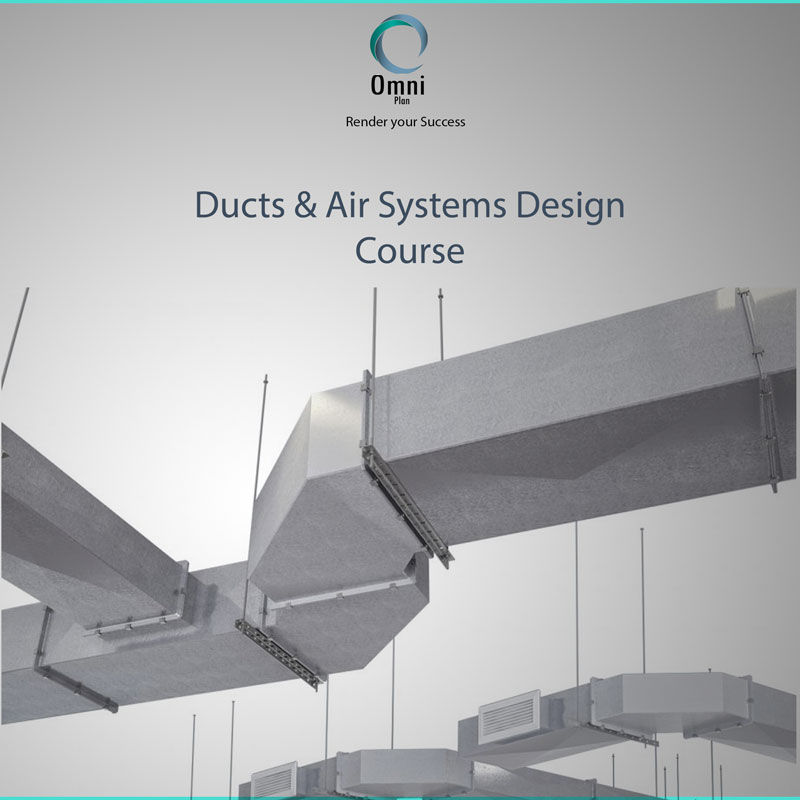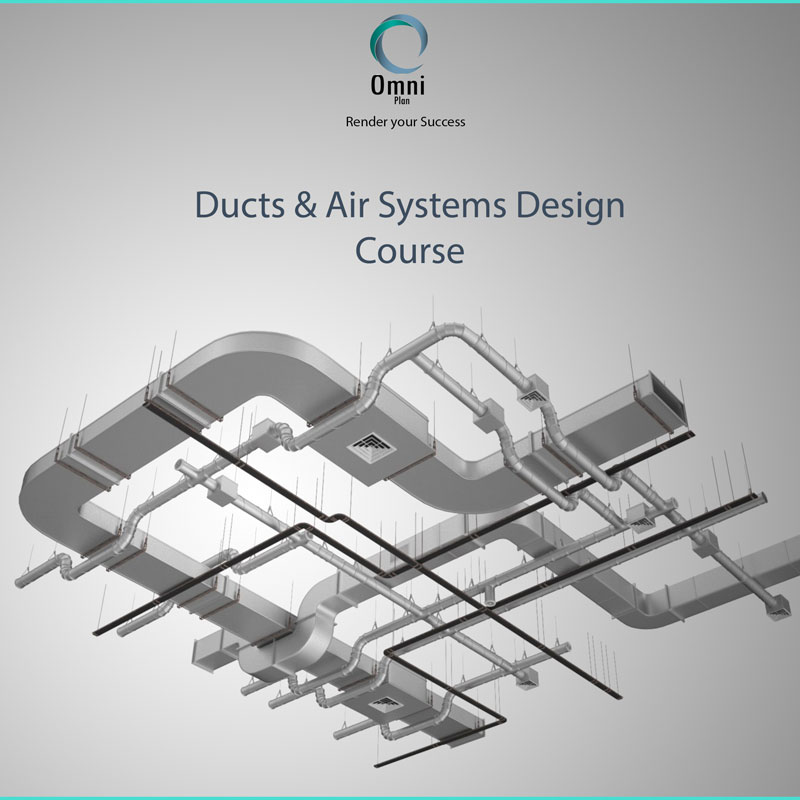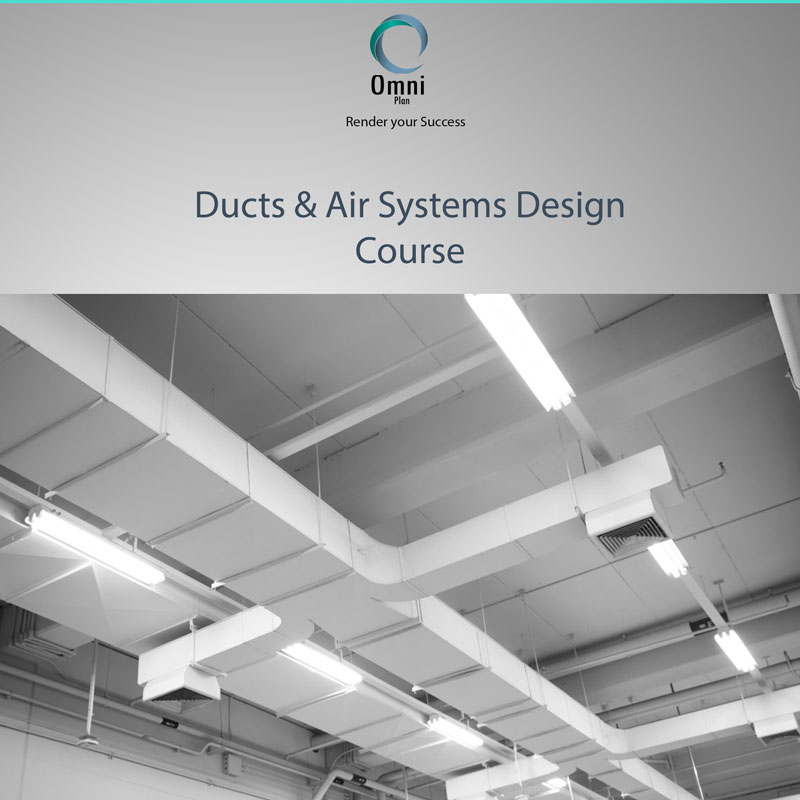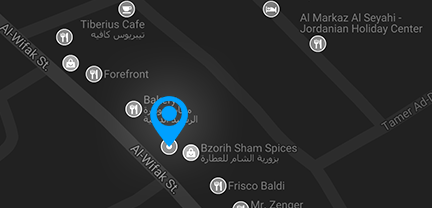Ducts & Air Systems Design
Course Information
Overview
Full understanding of air behavior and its characteristics, effect of changing external conditions, and changing its properties.
فهم كامل لسلوك الهواء ومواصفاته, تأثير الظروف الخارجية وتأثير تتغير خصائص الهواء.
How to use Psychrometric processes in air systems to condition spaces.
كيفية استعمال العمليات السايكرومترية في أنظمة تكييف الهواء.
Know all single zone and multiple zone systems, and the concept of work for each system
معرفة جميع أنظمة أحادية النطاق, ومتعددة النظاق, ومفهوم عمل كل نظام
Ability to size ducts by using all methods.
القدرة على تحديد أبعاد مجاري الهواء باستعمال جميع الطرق
Perform full calculations for fan, and take into consideration the factors effect on these calculations.
إنجاز حسابات كاملة للمروحة, وأخذ بعين الاعتبار العوامل المؤثرة في هذه الحسابات
Distribute inlet and outlet air terminals.
توزيع مداخل ومخارج الهواء
The methods that achieve comfort by controlling in space air diffusion.
الطرق التي يتم من خلالها تحقيق مستوى الراحة من خلال التحكم بكيفية انتشار الهواء داخل الحيزات
Use three important software programs in this field:
استعمال ثلاث برمجيات مهمة في هذا المجال:
- Elite Ductsize
- Duct sizer (McQuay)
- ASHRAE Duct Fitting Database
Objectives
HVAC field in general is more difficult than other mechanical fields such as Fire Fighting or Plumbing, that because:
- The main aim of HVAC is achieve comfort for people, or meet the needs of some particular applications, and this depends one a lot of conditions and factors
- Deal with several materials and phases. Where there are water, air, and a lot of types of refrigerant
- In other fields usually dealing is been with incompressible fluids, but in HVAC there is an air and it is compressible, so here more difficult occurs
- Wide range of options are available for each case, unlike other fields such that there are constant requirements have not to be changed
- Standards and references that used in this field are a lot comparison with Fire Fighting or Plumbing systems
This course is design course, so participant needs to know and understand a lot of fluid characteristics, whom this course is included
مجال التكييف والتبريد بشكل عام أكثر صعوبة من باقي المجالات الميكانيكية مثل مكافحة الحريق والسمكرة, وذلك بسبب :
- الهدف الرئيس من أنظمة التكييف والتبريد هو تحقيق الراحة للناس, أو تلبية احتياجات تطبيقات معينة, وهذا يعتمد على الكثير من الظروف والعوامل
- التعمال مع عدة مواد وأطوار, حيث هنالك مياه, هواء, والعديد من أنواع مواد التبريد
- في المجالات الأخرى يتم التعمال مع موائع غير قابلة للانضغاط, لكن في أنظمة التكييف والتبريد هنالك هواء, وهو قابل للانضغاط, مما يؤدي إلى مزيد من الصعوبة
- لدينا مجال واسع من الخيارات والبدائل لكل حالة, على عكس باقي المجالات حيث تكون هنالك متطلبات ثابتة لا يمكن تغييرها
- المعايير والمراجع المستخدمة في هذا المجال كثيرة ومتعددة مقارنة بأنظمة إطفاء الحريق والسمكرة
هذه الدورة هي دورة تصميمية, لذلك فالمشارك يحتاج أن يعرف ويفهم الكثير من خصائص الموائع, والتي تم تضمينها في هذه الدورة
Audience
مهندسو الميكانيك والعاملون في مجال الاستشارات الهندسية
مهندسو الميكانيك والعاملون في مجال المقاولات والإشراف
طلاب الهندسة الميكانيكية
Outline
- Module 1: Psychrometric Chart
- Dry bulb temperature
- Wet bulb temperature
- Dew point
- Specific humidity
- Saturation humidity
- Dew point
- Relative humidity
- Sensible heat factor
- Module 2: Psychrometric processes
- Sensible heating
- Sensible cooling
- Humidification
- Dehumidification
- Heating & humidification
- Cooling & humidification
- Heating & dehumidification
- Cooling & dehumidification
- Adiabatic mixing
- Non-adiabatic mixing
- Module 3: Air-Conditioning Systems
- Basic Air-Conditioning System
- Economizer
- Zoned Air-Conditioning Systems
- Single-Duct, Zoned Reheat, Constant-Volume Systems
- Single-Duct, Variable-Air-Volume Systems
- By-pass Box Systems
- Constant Volume Dual-Duct, All-Air Systems
- Multizone Systems
- Three-Deck Multizone Systems
- Dual-Duct, Variable-Air-Volume Systems
- Dual Path outside Air Systems
- System Choice Matrix
- Module 4: Bernoulli Equation
- Static Pressure
- Velocity Pressure
- Elevation Pressure
- Differences between these types of pressure
- Relations between energy and each type of pressure
- Module 5: Duct Shapes
- The shape effect on pressure loss
- Hydraulic Diameter
- Equivalent Diameter
- Rectangular-Round Equation
- Oval-Round Equation
- Comparison between Equal cross sectional area & Equal equivalent diameter:
- Aspect Ratio
- Advantages & disadvantages of each shape
- Module 6: Duct Sizing Methods
- Equal Friction
- Constant Velocity
- Velocity Reduction
- Static Regain
- Total Pressure
- Solve problems by these methods
- Module 7: Analyzing and Enhancing Supply Duct Systems
- Analyzing a preliminary supply design
- Balancing Equal Friction Designs
- * Balancing Dampers
- * Orifice Plates
- Enhanced Equal Friction Design
- Enhanced Static Regain Design
- Module: 8: Pressure Losses
- Pressure loss chart & Ductsize software (McQuay)
- Roughness Factor
- Losses in Flexible Duct
- Flexible Duct installation and considerations
- Dynamic loss in fittings & components
- Equivalent Length Method
- Local Loss Coefficient Method
- Duct fittings codes
- ASHRAE Duct Fittings Database software program
- Module 9: Fan Calculations
- Considerations of fan pressure calculation
- Total pressure in loss series path
- Total pressure in loss parallel path
- Fan total pressure and fan static pressure
- Supply fan & exhaust fan
- Solve problems
- Module 10: Fan/System Curves
- Fan performance curves
- Fan pressure performance curve for single fan speed
- Fan pressure performance curve for multi fan speed
- Fan Laws
- Catalog Performance Tables
- The system curve
- System Constant
- Fan/System Curve and System Design Point
- Effect of changes in fan speed
- Effect of density on system resistance
- Effects of errors in estimating required pressure
- Module 11: System Effect Factor (SEF)
- AMCA installation types
- System Effect Curves
- Outlet System Effect Factors
- * Outlet ducts
- * Outlet duct elbows
- * Volume control dampers
- * Duct branches
- Inlet System Effect Factors
- * Inlet ducts
- * Inlet duct elbows
- * Inlet vortex (spin or swirl)
- * Inlet turning vanes
- * Airflow straighteners
- * Enclosures (plenum and cabinet effects)
- * Obstructed inlets
- Module 12: Air Terminal Distribution
- Diffuser, grill, and register
- Air throw
- Supply distribution
- Exhaust distribution
- Noise criteria (NC)
- Short circuit
- Module 13: Elite Duct Size Software program
- Module 14: SPACE AIR DIFFUSION
- MIXED AIR DISTRIBUTION
- Principles of Operation
- Benefits and Limitations
- Methods of MIXED AIR DISTRIBUTION:
- * Horizontal Discharge Cooling with Ceiling-
- * Mounted Outlets
- * Vertical-Discharge Cooling or Heating with
- * Ceiling-Mounted Outlets
- * Cooling with Sidewall Outlets
- * Cooling with Floor-Mounted Air Outlets
- * Cooling with Sill-Mounted Air Outlets
- * Heating and Cooling with Perimeter Ceiling-
- * Mounted Outlets
- Space Temperature Gradients and Airflow Rates
- FULLY STRATIFIED AIR DISTRIBUTION
- Principles of Operation
- Typical Applications
- Benefits and Limitations
- Outlet Characteristics
- Space Temperature Gradients and Airflow Rates
- Methods of Evaluation
- PARTIALLY MIXED AIR DISTRIBUTION




